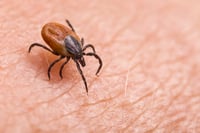A Danish study published online in Pediatrics this week reported a possible link between mothers...
Lyme Disease Heightens Risk of Mental Disorders, Suicidality, Study Finds

People in Denmark diagnosed with Lyme disease in a hospital went on to have 28% higher rates of mental disorders and were twice as likely to have attempted suicide, compared with those without the diagnosis, according to a study published Wednesday in AJP in Advance. Having more than one episode of Lyme disease was associated with a higher rate of mental disorders, affective disorders, and suicide attempts.
According to the CDC, nearly half a million people a year in the United States are treated for Lyme disease (also known as Lyme borreliosis), the most common vector-borne disease, and the areas where Lyme disease is common are expanding. Several studies have pointed to a connection between Lyme disease and psychiatric manifestations in people with untreated infection as well as months to years after antibiotic therapy, wrote Brian A. Fallon, M.D., M.P.H., of Columbia University and New York State Psychiatric Institute and colleagues. The current study is believed to be the first large population-based study examining the relationship between Lyme disease and psychiatric outcomes.
The researchers analyzed patient medical records for the nearly 7 million people living in Denmark and compared individuals diagnosed with Lyme disease in a hospital setting (n=12,616) with those without this diagnosis. Specifically, they examined cases of various mental disorders and suicidality among all individuals and adjusted the results based on known risk factors for mental illness such as sex, age, education level, socioeconomic status, and comorbidities. Patients who had a history of mental disorder or suicidality prior to the Lyme disease diagnosis were excluded from the analysis.
The analysis revealed that in addition to patients with Lyme disease being at greater risk of mental disorders and suicide attempts compared with those without this disease, they also had a 42% higher rate of affective disorders and a 75% higher rate of death by suicide. “Notably, the rate for affective disorders was highest during the first year after diagnosis and highest for completed suicide during the first 3 years after diagnosis,” Fallon and colleagues wrote.
“Our study focused on those whose Lyme disease was severe enough to require hospital contact,” Fallon told Psychiatric News. “Our results are therefore not surprising, given that individuals with hospital-based diagnoses of serious infections are known to have an increased risk of subsequent affective disorders and suicide.” The study results may not be generalizable to potentially less severe cases of Lyme disease that were handled outside the hospital.
Despite the findings, hospital-diagnosed cases of Lyme disease were not a major contributor to the overall rate of mental disorders or suicide in the general population, the authors noted. For example, the absolute rate for suicide of patients who were diagnosed with Lyme disease in the hospital was low, accounting for 25 fatalities over a 22-year period, representing 0.2% of all suicides during that time.
“Although the absolute population risk is low, clinicians should be aware of the potential psychiatric sequelae of this global disease,” Fallon and colleagues concluded.
For more on this topic, see the chapter on infectious diseases in The American Psychiatric Association Publishing Textbook of Psychosomatic Medicine and Consultation-Liaison Psychiatry from APA Publishing.
(Image: iStock/Ladislav Kubeš)
Don't miss out! To learn about newly posted articles in Psychiatric News, please sign up here.




-Jun-24-2025-03-54-55-2514-PM.jpg?height=200&name=shutterstock_106137044%20(1)-Jun-24-2025-03-54-55-2514-PM.jpg)

